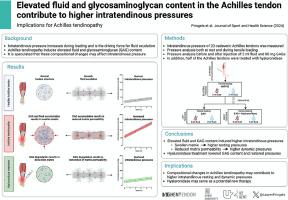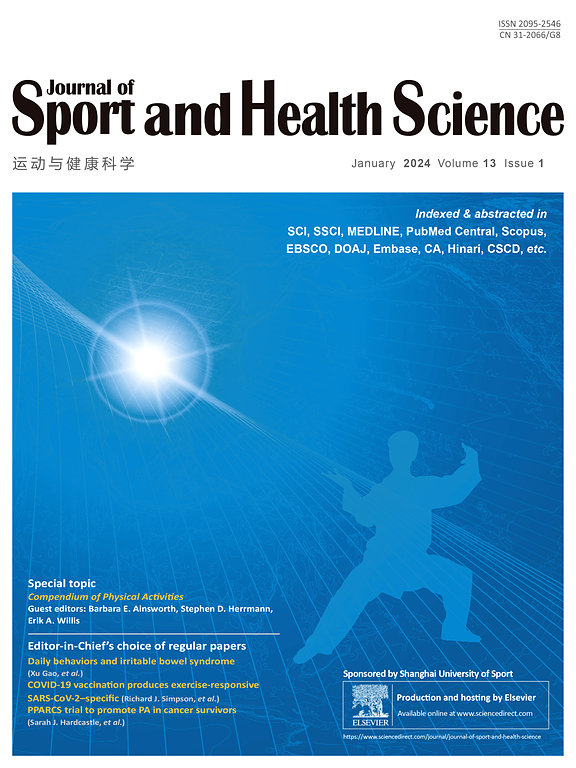Elevated fluid and glycosaminoglycan content in the Achilles tendon contribute to higher intratendinous pressure: Implications for Achilles tendinopathy
IF 9.7
1区 医学
Q1 HOSPITALITY, LEISURE, SPORT & TOURISM
引用次数: 0
Abstract
Tendinopathy alters the compositional properties of the Achilles tendon by increasing fluid and glycosaminoglycan content. It has been speculated that these changes may affect intratendinous pressure, but the extent of this relationship remains unclear. Therefore, we aimed to investigate the impact of elevated fluid and glycosaminoglycan content on Achilles tendon intratendinous pressure and to determine whether hyaluronidase (HYAL) therapy can intervene in this potential relationship. Twenty paired fresh-frozen cadaveric Achilles tendons were mounted in a tensile-testing machine and loaded up to 5% strain. Intratendinous resting (at 0% strain) and dynamic pressure (at 5% strain) were assessed using the microcapillary infusion technique. First, intratendinous pressure was measured under native conditions before and after infusion of 2 mL physiological saline. Next, 80 mg of glycosaminoglycans were administered bilaterally to the paired tendons. The right tendons were additionally treated with 1500 units of HYAL. Finally, both groups were retested, and the glycosaminoglycan content was analyzed. It was found that both elevated fluid and glycosaminoglycan content resulted in higher intratendinous resting and dynamic pressures ( < 0.001). HYAL treatment induced a 2.3-fold reduction in glycosaminoglycan content ( = 0.002) and restored intratendinous pressures. The results of this study demonstrated that elevated fluid and glycosaminoglycan content in Achilles tendinopathy contribute to increased intratendinous resting and dynamic pressures, which can be explained by the associated increased volume and reduced permeability of the tendon matrix, respectively. HYAL degrades glycosaminoglycans sufficiently to lower intratendinous pressures and may, therefore, serve as a promising treatment.

跟腱中液体和糖胺聚糖含量升高导致腱内压力升高:对跟腱病的影响
跟腱病会通过增加液体和糖胺聚糖含量来改变跟腱的组成特性。据推测,这些变化可能会影响腱内压,但这种关系的程度仍不清楚。因此,我们旨在研究液体和糖胺聚糖含量升高对跟腱内压力的影响,并确定透明质酸酶(HYAL)疗法是否能干预这种潜在的关系。将 20 根成对的新鲜冷冻跟腱安装在拉伸试验机中,并加载至 5%应变。使用微毛细管灌注技术对腱内静态压力(0% 应变时)和动态压力(5% 应变时)进行评估。首先,在注入 2 毫升生理盐水之前和之后,测量原始条件下的腱内压力。然后,在双侧成对肌腱中注入 80 毫克氨基糖。右侧肌腱另外注射了 1500 单位的 HYAL。最后,对两组肌腱进行复测,分析糖胺聚糖的含量。结果发现,液体和糖胺聚糖含量升高会导致肌腱内静态和动态压力升高(< 0.001)。HYAL 治疗可使糖胺聚糖含量降低 2.3 倍(= 0.002),并恢复腱内压力。这项研究的结果表明,跟腱病变中液体和糖胺聚糖含量的升高会导致腱内静息压力和动态压力的升高,这可以分别用相关的肌腱基质体积增大和渗透性降低来解释。HYAL 能充分降解糖胺聚糖,从而降低腱鞘内压力,因此是一种很有前景的治疗方法。
本文章由计算机程序翻译,如有差异,请以英文原文为准。
求助全文
约1分钟内获得全文
求助全文
来源期刊

Journal of Sport and Health Science
SPORT SCIENCES-
CiteScore
18.30
自引率
1.70%
发文量
101
审稿时长
22 weeks
期刊介绍:
The Journal of Sport and Health Science (JSHS) is an international, multidisciplinary journal that aims to advance the fields of sport, exercise, physical activity, and health sciences. Published by Elsevier B.V. on behalf of Shanghai University of Sport, JSHS is dedicated to promoting original and impactful research, as well as topical reviews, editorials, opinions, and commentary papers.
With a focus on physical and mental health, injury and disease prevention, traditional Chinese exercise, and human performance, JSHS offers a platform for scholars and researchers to share their findings and contribute to the advancement of these fields. Our journal is peer-reviewed, ensuring that all published works meet the highest academic standards.
Supported by a carefully selected international editorial board, JSHS upholds impeccable integrity and provides an efficient publication platform. We invite submissions from scholars and researchers worldwide, and we are committed to disseminating insightful and influential research in the field of sport and health science.
 求助内容:
求助内容: 应助结果提醒方式:
应助结果提醒方式:


